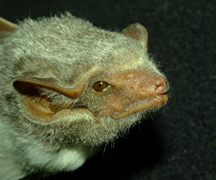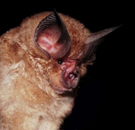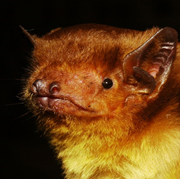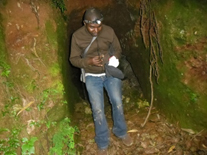|

|
Emeritus Associate Professor David Jacobs |
RESEARCH INTERESTS
|
My research focuses on the processes involved in trait evolution and how divergence in traits lead to lineage diversification and the consequent generation of biodiversity. I focus on sensory, behavioural and morphological traits. My group uses several approaches in this research including comparative morphometrics and behavioural ecology to test hypotheses on the functional significance of trait variation. This approach includes the use of genetic techniques to identify evolutionary relationships amongst species/lineages which are in turn used to construct ancestral character states. These are used in conjunction with phenotypic data to test several hypotheses on trait evolution. Current research projects include:
|

|
I have chosen insectivorous bats as the system to work on because their evolution of flight and echolocation allows one to understand the interaction between a sensory system that provides information about space and time and a morphological system that allows the negotiation of that space. The morphology (and nervous system) associated with flight and echolocation should be under extreme selection pressure because of the stringent conditions under which they have to operate as a result of the limitations imposed by acoustics and aerodynamics.
This work is done at various sites around the world but mainly in southern Africa in collaboration with my students and colleagues at various institutions in South Africa and elsewhere in the world.
Publications
Books and Chapters in Books
Jacobs, D.S. & Bastian, A. 2016. Predator-Prey Interactions: coevolution between bats and their prey. Springer International Publishing, SpringerBriefs in Animal Sciences.
This book can be downloaded for strictly non-commercal purposes at the following link: [ pdf ]
Jacobs, D.S. 2016. Evolution’s chimera: Bats and the marvel of evolutionary adaptation. UCT Press, Cape Town.
Jacobs, D.S. Mutumi, G.L. Maluleke, T. Webala, P. 2016. Convergence as an evolutionary trade-off in the evolution of acoustic signals: echolocation in horseshoe bats as a case study. in Evolutionary Biology: Convergent evolution, evolution of complex traits, concepts and methods (ed) P. Pontarotti. Springer Press, Heidelberg.
Korine, C., Adams, R.A., Russo, D., Jacobs, D., 2016. The association between bats and the water they use: implications for species distribution, ecology, and management plans pp 215-241 in Bats and the Anthropocene: Conservation of bats in a changing world (eds) C.C. Voigt & T. Kingston. Springer Press, New York.
Selected articles in refereed scientific journals
Petersen, H., Finger, N., Bastian, A. & Jacobs, D. 2018. The behaviour and vocalisations of captive Geoffroy’s horseshoe bat, Rhinolophus clivosus (Chiroptera: Rhinolophidae). Acta Chiropterologica, 20(2):439-453.
Jacobs, D.S. & Bastian, A. 2018. High Duty Cycle echolocation may constrain the evolution of diversity within horseshoe bats (Family: Rhinolophidae). Diversity: 2018, 10, 85; doi:10.3390/d10030085.
Raw, N.V., Bastian, A. & Jacobs, D.S. 2018. It’s not all about the soprano: rhinolophid bats use multiple acoustic components in echolocation pulses to discriminate between conspecifics and heterospecifics. PLOS ONE 13(7): e0199703. https://doi.org/10.1371/journal.pone.0199703
Jacobs, D.S., Catto, S., Mutumi, G.L., Finger, N. & Webala, P.W. 2017 Testing the Sensory Drive Hypothesis: Geographic variation in echolocation frequencies of Geoffroy’s horseshoe bat (Rhinolophidae: Rhinolophus clivosus). PLoS ONE 12(11): e0187769. https://doi.org/10.1371/journal.pone.0187769.
Maluleke, T., Jacobs, D.S. & Winker, H. 2017. Environmental correlates of geographic divergence in a phenotypic trait: a case study using bat echolocation. Ecology and Evolution, 2017: 1-15. http://dx.doi.org/10.1002/ece3.3251.
Bastian, A., Finger, N. & Jacobs, D.S. 2017. To seek or speak: dual function of an
acoustic signal limits its versatility in communication. Animal Behaviour, 127: 135–152. http://dx.doi.org/10.1016/j.anbehav.2017.03.005.
Dool, S.E., Puechmaille, S.J., Foley, N.M., Allegrini, B., Bastian, A.,
Mutumi, G.L., Maluleke, T., Odendaal, L.J. Teeling, E.C. & Jacobs, D.S. 2016. Nuclear introns outperform mtDNA in phylogenetic reconstruction: lessons from horseshoe bats (Rhinolophidae: Chiroptera). Molecular Phylogenetics & Evolution, 97: 196–212.
Mutumi, G.L., Jacobs, D.S. & Winker, H. 2016. Sensory drive mediated by climatic
gradients partially explains divergence in acoustic signals in two horseshoe bat species, Rhinolophus swinnyi and Rhinolophus simulator. PLoS ONE, 11(1): e0148053. doi:10.1371/journal.pone.0148053.
Fawcett, K., Jacobs, D.S., Surlykke, A. & Ratcliffe, J.M. 2015. Echolocation in the bat, Rhinolophus capensis: the
influence of clutter, conspecifics and prey on call design and intensity. Biology Open, (2015) 0, 1–9 doi:10.1242/bio.201511908.
Foley, N., Vu dinh, T., Goodman, S., Armstrong, K., Jacobs, D., Puechmaille, S., Teeling,. E. (2015). How and
why overcome the impediments to resolution: lessons from rhinolophid and hipposiderid bats. Molecular Biology and Evolution, 32(2): 313–333.
Bastian, A. & Jacobs, D.S. 2015. Listening carefully: increased perceptual acuity for species discrimination in multispecies signalling assemblages. Animal Behaviour, 101: 141-154.
Jacobs, D.S., Bastian, A. & Bam, L. 2014. The influence of feeding on the evolution of sensory signals: a comparative test of an evolutionary trade-off between masticatory and sensory functions of skulls in southern African Horseshoe bats (Rhinolophidae). Journal of Evolutionary Biology, 27: 2829-2840. Doi: 10.1111/jeb.12548.
Odendaal, L.J., Jacobs, D.S. & Bishop, J.M. 2014. Sensory trait variation in an echolocating bat suggests roles for both selection and plasticity. BMC Evolutionary Biology, 14:60 doi:10.1186/1471-2148-14-60.
Jacobs, D.S., Babiker, H., Bastian, A., Kearney, T., Van Eeden, R. & Bishop, J.M. 2013. Phenotypic convergence in genetically distinct lineages of a Rhinolophus species complex (Mammalia, Chiroptera). PLoS ONE, 8(12): e82614. doi:10.1371/journal.pone.0082614.
Sirami, C., Jacobs, D.S. & Cumming, G.S. 2013. Artificial wetlands and surrounding habitats provide important foraging habitat for bats in agricultural landscapes in the Western Cape, South Africa. Biological Conservation, 164:30-38.
Stoffberg, S., Jacobs, D.S. & Matthee, C.M. 2011. The divergence of echolocation frequency in horseshoe bats: moth hearing, body size or habitat? Journal of Mammalian Evolution. 18:117-129.
Miller-Butterworth, C.M., Jacobs, D.S. & Harley, E.H. 2003. Strong population substructure correlates with morphology and ecology in a migratory bat. Nature, 424: 187-191.
Media
New technology reveals call behaviour [ pdf ]
Group Members
Research Assistant
Alicia Thomas
Postdoctoral Fellows
Anna Bastian
Nicolas Nesi
Doctoral Students
Gregory Mutumi
Robert Raw
Tinyiko Maluleke
Nikita Finger
Mandy Mason
Research Assistant
|

|
Alicia Thomas |
Alicia is passionate about nature and the intricate balance between the environment and the life it supports. She believes that the conservation of our natural heritage requires a sound base of scientific knowledge, combined with proper education of the public, and hands on involvement on the ground. She has devoted much of her life to furthering her knowledge and understanding of nature, with the hope of applying her knowledge to make a difference.
Alicia graduated with a BSc in Zoology and Biodiversity & Evolutionary Biology in 2006. She then went on to complete a BSc. Honours in Botany in 2007, which involved two mini-theses, one on using Sporormiella to track herbivore biomass within the Hluhluwe-Imfolozi Game Reserve, and a second using isotope analysis to trace the effect of aquaculture effluent on nitrogen uptake in kelp (Ecklonia maxima) and mussels (Mytilus galloprovincialis). Her master’s degree was completed in 2011 under the supervisor of Prof David Jacobs, looking at the factors affecting emergence time of insectivorous bats in South Africa. She is a member of the Zoological Society of South Africa (ZSSA) and South African Bat Assessment Association (SABAA). She also holds an accreditation from SACNASP (South African Council for Natural Scientific Professions) as a Professional natural Scientist in Zoological science. She is currently working with the UCT Animal Evolution and Systematics group as research assistant to Prof David Jacobs.
After graduating with her MSc. in 2011, Alicia founded Gaia Environmental Services, for which she still holds the position of Managing Director. Gaia, a small start-up company, conducts environmental impact assessments largely for the development of wind energy facilities.
Postdoc fellows:
Dr. Anna Bastian
|

|
NRF Postdoctoral Fellow |
Evolution of Animals: Animal Behaviour, Ecology and Genetics.
keywords: communication, bioacoustics, sensory ecology, population genetics, evolutionary ecology, phylogenetics
Research interests Bioacoustics and Biodiversity
My general research interest is the evolution of animals with a focus is on animal communication and phenotypic diversity.
I am especially interested in the evolution of mammalian vocal communication systems to investigate if, what and how animals communicate and which features of mammalian communication might reflect universals also found in human spoken language.
Complementary to this I aim to understand the causes, mechanisms and consequences of phenotypic trait variation in mammals.
Research on the evolution of biodiversity inherently requires an integrative approach comprising behaviour, morphology, ecology and molecular approaches. I incorporate all of these approaches in my research.
Much of my research has involved the study of bats as model systems and the use of DNA sequences and phenotypic data such as morphological (e.g. wingshape) and acoustic (social calls and echolocation) data. An important tool of my projects are experimental approaches using playbacks, behavioural observations, manoeuvrability courses, prey capture success tasks etc.
I combine these approaches to build a strong complementary strategy to characterize variation, to describe patterns and to identify their underlying mechanisms to ultimately make inferences about the species’ evolutionary history.
- DNA sequence data allow me to reconstruct species relationships, to date periods of diversification and to assess gene flow patterns and histories between populations
- Phenotypic data in combination with ecological data can elucidate how species adapt to their environment as well as uncover the forces of selection involve
- Experimental methods help to test and compare the function of phenotypic traits and to assess the sensory and morphological ecology of populations or species
- Behavioural studies shed light on crucial aspects of the biology of a species and thus evolution. I study the acoustic communication of bats which involves both, ultimate (evolutionary) and the proximate (functional) questions
Publications
Listening carefully: increased perceptual acuity for species discrimination in multispecies signalling assemblages. Bastian, A., & Jacobs, D. S. (2015). Animal Behaviour, 101(0), 141-154.
The influence of feeding on the evolution of sensory signals: a comparative test of an evolutionary trade-off between masticatory and sensory functions of skulls in southern African Horseshoe bats (Rhinolophidae). Jacobs, D. S., Bastian, A., & Bam, L. (2014). Journal of Evolutionary Biology, 27(12), 2829-2840.
Phenotypic Convergence in Genetically Distinct Lineages of a Rhinolophus Species Complex (Mammalia, Chiroptera). Jacobs, D. S., Babiker, H., Bastian, A., Kearney, T., van Eeden, R., & Bishop, J. M. (2013). PLoS ONE, 8(12).
Diversity in the Cuban bat species, Macrotus waterhousii - Relevance of variation in echolocation, foraging behaviour, social interactions and genetic markers in two morphotypes. Bastian, A. (2012). Stuttgart, Germany: Suedwestdeutscher Verlag fuer Hochschulschriften. doi:
Affect cues in vocalizations of the bat, Megaderma lyra, during agonistic interactions. Bastian, A., & Schmidt, S. (2008). Journal of the Acoustical Society of America, 124(1), 598-608.
Research Projects and Questions
Acoustic communication in horseshoe bats.
Do bats use echolocation to communicate?
Is echolocation a magic trait?
1. Echolocation as a communication signal
We test the acoustic communication hypothesis with a set of playback experiments. We test species,
gender and individual discrimination ability as well as mate choice based on echolocation
Which social calls have evolved in bats and what do these calls mean?
2. Vocal repertoire of social calls in R. clivosus
We study context-specific social calls and match calls with behaviours, situations and individuals
The evolution of signal divergence.
Is the observed variation in echolocation within and between species the result of natural selection?
Can the differences in echolocation between populations be caused by different co-signalling sympatric species?
Can the difference in echolocation between populations lead to the establishment of a reproductive barrier?
Causes and consequences of intra-and inter-specific differences of echolocation calls in various horseshoe bats species.
We combine population genetics with acoustic, morphological and ecological data to understand the geographic variation of focal traits such as echolocation.
Phylogenetic reconstructions and Population genetics of various horseshoe bat species.
How many species are there?
Do phenotypic variations reflect phylogenetic constraints?
When did lineages diverge?
Bases for all population based projects is knowledge about taxonomic relationships and diversity.
What restricts gene flow between populations?
Are there events of introgression and hybridisation evident in closely related species?
Does ecology explain patterns of gene flow and phenotypic variation? (Landscape genetics)
Taxonomic assessment of a Cuban bat species on population level.
Do the morphotypes found on Cuba represent one interbreeding population?
Are the morphotypes found on Cuba representatives of different colonisation events?
Population genetics and phylogenetic inference on populations of the Cuban bat, Macrotus waterhousii.
Functional morphology.
Do differences between morphotypes translate into performance differences in an obstacle flight course?
This experimental research examines if size and wing shape differences lead to different manoeuvrability and therefore different accessibility to habitat niches.
Sensory ecology.
Do differences between phonetic types translate into differences in prey capture success?
This experiment exposed different phonetic-types to different levels of cluttered environments in which they had to find prey.
Can gleaning bats find prey without passive listening and by echolocation only?
This experiment exposed different phonetic-types to different levels of rustling sounds generated by its prey.
Acoustic cues of emotional communication.
Do bats communicate different levels of emotional arousal and are these prosodic cues perceived?
i) We analysed agonistic interactions between two individuals of the Indian false vampire bat, and tested if a) bats encode different levels of aggression in their call structure and b) if these different aggression levels are perceived by the other bat.
ii) We analysed courtship behaviour of male bats towards females and tested if differences in the intensity of rejection of the females is perceived by the male and changed its subsequent behaviour.
|

|
Dr Nicolas Nesi |
Research interests
Nicolas received his PhD from the National Museum of Natural History (MNHN), Paris, France for a thesis on the molecular systematics and phylogeography of African fruit bats of the sub-family Epomophorinae (Chiroptera, Pteropodidae). This work proposed a new classification of the sub-family Epomophorinae including the description of several new species, tested the reliably of the ‘barcoding approach’ on African fruit bats and highlighted cases of mitochondrial DNA introgression in a complex of species. It also provided insight itn the roles of Plio-Pleistocene climatic fluctuations and forests refugia in shaping the evolution and diversity of these taxa, particularly for the potential of this group of bats to act as natural reservoir species of the Ebola virus.
In the Animal Evolution and Systematics group (Biological department, UCT), Nicolas’ postdoctoral research focuses on evolutionary biological studies of southern African horseshoes bats (Chiroptera, Rhinolophus) using molecular data. His main focus is using mitochondrial and microsatellite analyses to understand the origin and maintenance of geographic variation in echolocation call frequencies despite gene flow in the Cape horseshoe bat (Rhinolophus capensis). He is also involved in several other projects including the evolutionary history of species complex in R. simulator and R. swinnyi using an integrative approach combining molecular, morphologic and sensory data. The newly developed microsatellites markers used in these projects will also be used to determine paternity in a study on the role that echolocation plays in mate choiceR. clivosus.
His research interests focuses on molecular systematics and biogeography of bats from Africa. He is especially interested in the genetics of speciation and the phenomena of introgression and hybridization. In the future Nicolas hopes to use a comparative genomics approach to study dietary specialisation in fruit bats.
Publications
Nesi, N., Jacobs, D.S., Felheim, K. & Bishop, J.M. 2015. Development and characterization of 10 microsatellite markers in the Cape horseshoe bat, Rhinolophus capensis (Chiroptera, Rhinolophidae) and cross-amplification in southern African Rhinolophus species. BMC Research Notes, 8:477 DOI 10.1186/s13104-015-1465-5
Hassanin, A., Khouider, S., Gembud, G-C., Goodman, SM., Kadjo, K., Nesi, N., Pourrut, X., Nakoune, E., Bonillo, C. 2015. The comparative phylogeography of fruit bats of the tribe Scotonycterini (Chiroptera, Pteropodidae) reveals cryptic species diversity related to African Pleistocene forest refugia. C. R. Biologies 338: 197–211.
Nesi, N., Kadjo, B, Pourrut, X., Leroy, E., Shongo, CP., Cruaud, C., Hassanin, A. 2013. Molecular systematics and phylogeography of the tribe Myonycterini (Mammalia, Pteropodidae) inferred from mitochondrial and nuclear markers. Molecular Phylogenetics and Evolution 66: 26–137.
Nesi, N., Nakoune, E., Cruaud, C, Hassanin, A. 2011. DNA barcoding of African fruit bats (Mammalia, Pteropodidae). The mitochondrial genome does not provide a reliable discrimination between Epomophorus gambianus and Micropteropus pusillus. C. R. Biologies 334 (2011) 544–554.
Doctoral students
|

|
Gregory Mutumi |
PhD Thesis: Geographic variation in the phenotypes of two sibling horseshoe bats Rhinolophus simulator and R. swinnyi
Research Interests
|
Gregory Mutumi was born in the Eastern Highlands of Zimbabwe. His interests are the causes of geographic variation in animal phenotypes in the context of lineage diversification and the generation of biodiversity. He focuses on southern African horseshoe bats (Rhinolophidae) as a model system. He uses several approaches to study geographic variation in these bats including ecological sampling, sensory ecology, microcomputer tomography to generate 3D images of bat skulls, geometric morphometrics and global positioning systems. His analyses emplys Lande’s model to teasing apart the relative contributions of natural selection and random drift to geographic variation. |

|
Publications
2011: Cumming, G.S., Caron, A., Abolnik, C., Cattoli, G., Bruinzeel, L.W., Burger, C.E., Cecchettin, K., Chiweshe, N., Mochotlhoane, B., Mutumi, G.L. & Ndlovu, M. Ecohealth IP. The ecology of Influenza A viruses in wild birds in southern Africa. IF 1.64
2012: Cumming, G.S., Ndlovu, M., Mutumi, G.L. & Hockey, P.A.R. Fresh Water Biology. Wader response to water quality at Barberspan wetland in the North Western province of South Africa. IF 3.29
2013: Mduduzi Ndlovu, Graeme S. Cumming, Philip A.R. Hockey, Mbongeni D. Nkosi, Leo W. Bruinzeel and Gregory L. Mutumi. A study of moult-site fidelity of Egyptian Geese Alopochen aegyptiaca in South Africa. Journal of African Zoology. IF 1.018
Robert Raw
|

|
Robert Raw |
PhD:
Research interests and background
Robert is a passionate naturalist, with a keen interest in animal behaviour, ecology and conservation. Based at the University of Cape Town since 2006, he is currently enrolled in a PhD with the UCT Animal Evolution and Systematics group.
Robert graduated with a BSc in Zoology and Ecology 2008, with recognition on the deans merit list. In 2009, he completed an honours degree in Zoology, with mini theses on the movements of Cape Dwarf Chameleons and the photo-identification of Sevengill Sharks. He then continued his research on Sevengill sharks to complete an MSc in Zoology in 2012, examining the population structure and fine-scale habitat use of the species in False Bay. His research earned him a place in the Golden Key International Honours Society in 2013.
His PhD, under the supervision of Prof David Jacobs, who heads the AES, focuses on the use of echolocation in communication and mate choice in horseshoe bats. Echolocation, which evolved primarily for use in orientation and foraging, has evolved the additional function of communication and therefore provides an ideal system to investigate the evolution of traits in mammals that have a dual function. Robert’s research involves the use of behavioural playback experiments to determine the ability of bats to not only discriminate between different classes of echolocation calls, but to use this information to make informed behavioural choices. Much of the previous work on the subject has focused on the role of call frequency in communication. Recent studies, however, have suggested that bats are able to differentiate between calls even when frequencies are similar. Multiple components of echolocation may therefore influence a bat’s ability to discriminate between species. Robert’s research thus investigates the roles of individual components of echolocation in communication and how these components influence mate choice in the context of lineage divergence.
|

|
Tinyiko Maluleke |
Research interests
Tinyiko Maluleke, is currently completing his PhD at the University of Cape Town under the supervision of A/Prof David Jacobs, who heads the Animal Evolution & Systematics (AES) Group in the Department of Biological Sciences. Tinyiko is fascinated by bats which are unique amongst mammals in their ablity to fly while using echolocation to orient and hunt in complete darkness. His research focuses on two African horseshoe bat species (family Rhinolophidae), Rhinolophus damarensis and Rhinolophus fumigatus. Tinyiko is interested in inderstanding diversification within and between horseshoe bat species and their adaptation to different climatic conditions with a view to understanding the relationship between morphology, behaviour, ecology and geography. Horseshoe bats are one of the most diverse families of bats. Of the 77 species in this family, 24 of them are found in Africa. Both R. damarensis and R. fumigatus have wide geographic distributions in Africa and such wide geographic distributions may have led to geographic variation within both species. This makes them ideal organisms for the study of geographic variation. Tinyiko’s research tests two sets of hypotheses: Vicariance and Adaptation Hypotheses. Vicariant events may have led to the spatial separation of a once continuous population into several populations which then differentiated from each other in allopatry. Alternatively, different populations of the same species may also experience natural selection and become adapted to local environments which may vary from one habitat to the next (Adaptation Hypothesis). His research will confirm the species status of each species to ensure that neither include cryptic species. This will be done in close collaboration with an on-going phylogenetic study done in the AES.
|

|
Nikita Finger |
Research interests
Nikita is interested in the super senses of animals and is passionate about the study of sound and enjoys unravelling the complexities of biosonar. Nikita’s MSc research, under the supervision of Prof David Jacobs at the University of Cape Town investigated the use of echolocation in intraspecific communication and mate recognition as well as the constraints imposed on these co-opted functions by the primary function of orientation and foraging. In habituation-dishabituation experiments high duty cycle echolocating bats, Rhinolophus clivosus, of both genders, were able to distinguish between the echolocation calls of different individuals as well as between genders. Bats reacted to the playbacks of echolocation calls with a variety of behaviours. To the best of our knowledge, this is the first study to demonstrate behavioural evidence for the perception of individual signatures and the second study to demonstrate the perception of gender signatures of echolocation calls by high duty cycle bats. Strong individual and gender signatures were found in the acoustic stimuli of the playback calls. Individual but not gender signatures were weakened when many individuals were involved. Modified echolocation calls yielded stronger individual signatures in larger groups than non-modified calls. In addition weak location signatures from five different locations in South Africa were found. These findings suggest that although echolocation can be used for intraspecific communication and mate recognition, the evolution of signal design for communication is constrained by the primary function of echolocation, viz. orientation and foraging. Nikita was awarded the MSc with distinction.
Nikita was born in South Africa and immigrated with her family to the United States at the age of nine. She is a graduate of the University of Central Florida where she was awarded a Bachelor of Science in biology and psychology, Cum Laude. Upon her return to South Africa she completed her Honours degree in Zoology at the University of Cape Town and followed this with an MSc also in Zoology. Her PhD research supervised by by David Jacobs and Marc Holderied (Bristol University) investigates the influence of habitat on the echolocation behaviour of horseshoe bats. Horseshoe bats are thought to be clutter specialists and supposedly use different habitats in the same way. Habitat should therefore exert no influence on the echolocation behaviour of these bats, yet they occur in haibtats ranging from desert to forest and have very divergent calls both within and between species.
